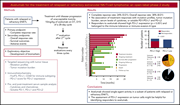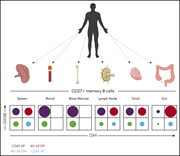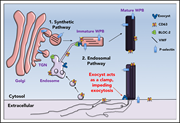Issue Archive
Table of Contents
BLOOD COMMENTARIES
REVIEW ARTICLE
Cancer immunoediting and immune dysregulation in multiple myeloma
The progression from monoclonal gammopathy to smoldering myeloma and then to multiple myeloma is associated with minimal genetic changes and relies primarily on changes in the marrow microenvironment. Nakamura and colleagues review the current understanding of the modulation of the immune environment that allows malignant plasma cells to evade immune elimination and promote disease progression.
HOW I TREAT
How I perform hematopoietic stem cell transplantation on patients with a history of invasive fungal disease
Puerta-Alcalde and colleagues discuss their approach to the challenging problem of stem cell transplantation for patients with a history of invasive fungal disease.
CLINICAL TRIALS AND OBSERVATIONS
Avelumab for the treatment of relapsed or refractory extranodal NK/T-cell lymphoma: an open-label phase 2 study
Clinical Trials & Observations
Extranodal natural killer/T-cell lymphoma (ENKTL) is an Epstein-Barr virus–positive lymphoma with poor prognosis that may respond to immunomodulatory therapy. Kim and colleagues report the results of a phase 2 study of the anti–programmed cell death ligand 1 (PD-L1) antibody avelumab in 21 patients with relapsed or refractory ENKTL. While nonresponders showed rapid progression, 25% of patients achieved complete remission, with response correlated with tumor PD-L1 expression.
HEMATOPOIESIS AND STEM CELLS
MYC-induced human acute myeloid leukemia requires a continuing IL-3/GM-CSF costimulus
The authors investigated the importance of cytokine stimulation in the evolution of hematopoietic stem cells with a leukemogenic mutation in c-MYC to AML. They demonstrated that in the absence of cytokine stimulation, transduction of human CD34+ cells with an MYC vector does not lead to AML in immunodeficient mice. However, transduction of both primitive stem cells and later progenitors with a mutant c-MYC rapidly induces AML in the presence of human interleukin-3 (IL-3) and granulocyte-macrophage colony-stimulating factor (GM-CSF).
IMMUNOBIOLOGY AND IMMUNOTHERAPY
Comprehensive analyses of B-cell compartments across the human body reveal novel subsets and a gut-resident memory phenotype
Weisel et al report an analysis of B-cell compartments across multiple tissues from healthy cadaveric donors and demonstrated that B cells in tissues are distinct from B cells circulating in peripheral blood. They defined several distinct populations of B cells residing in different tissues, including a distinct subtype of tissue-resident memory B cells restricted to the gut.
LYMPHOID NEOPLASIA
Noncanonical effector functions of the T-memory–like T-PLL cell are shaped by cooperative TCL1A and TCR signaling
Oberbeck et al investigated the immunopathologic characteristics of T-cell prolymphocytic leukemia (T-PLL), a poor-prognosis lymphoproliferative neoplasm. They describe T-PLL as a proliferation of memory-type T cells with constitutive activation of the TCL1A oncogene that has hypersensitive response to T-cell receptor (TCR)–mediated activation and loss of negative-regulatory TCR coreceptors. This leads to accumulation of apoptosis-resistant hyperproliferative tumor cells.
Outcome of primary mediastinal large B-cell lymphoma using R-CHOP: impact of a PET-adapted approach
Clinical Trials & Observations
Primary mediastinal large B-cell lymphoma is a rare lymphoma subtype associated with bulky mediastinal mass and usually presents in young females. Its prognosis has been greatly improved by adding rituximab to chemotherapy and radiotherapy (RT). Investigators from the British Columbia Cancer Centre report results of positron-emission tomography (PET)–directed RT following chemoimmunotherapy, identifying a subset of patients with excellent prognosis without radiation.
MYELOID NEOPLASIA
TP53 mutations in myelodysplastic syndromes and secondary AML confer an immunosuppressive phenotype
Myelodysplastic syndromes (MDSs) and secondary acute myeloid leukemia (AML) carrying TP53 mutations have a particularly dismal prognosis. The authors delineate the immunologic features of this subset of myeloid malignancy, demonstrating that TP53-mutant MDSs/AMLs display an immunosuppressive phenotype portending poor prognosis, characterized by upregulated PD-L1 expression and reduced marrow cytotoxic T cells. Although early studies of immunotherapy in MDS/AML have been disappointing, these studies suggest that immunomodulation may have an impact in this subset of myeloid malignancy.
THROMBOSIS AND HEMOSTASIS
VWF maturation and release are controlled by 2 regulators of Weibel-Palade body biogenesis: exocyst and BLOC-2
Sharda et al explored the mechanism of von Willebrand factor (VWF) packaging into and release from Weibel-Palade bodies (WPBs) by defining the interaction of biogenesis of lysosome-related organelle-2 (BLOC-2) and the exocyst complex. BLOC-2 and exocyst bind to one another and facilitate formation of WPBs; they have divergent influences on WBP release, with BLOC-2 permissive for, and exocyst preventing, WPB release. This suggests that modulation of exocyst could increase VWF release.
BLOOD WORK
-
Cover Image
Cover Image
![issue cover]()
Prooncogenic TCL1A augments T-cell activation in a murine model of T-cell prolymphocytic leukemia. T-cell receptor activation of spleen-infiltrating, transplanted Lckpr-hTCL1Atg transgenic T cells (host: CEAtg mice; IF overlay: red, CD3; yellow, pCD3ζ; blue, nucleus) is shown. See the article by Oberbeck et al on page 2786.
- PDF Icon Front MatterFront Matter
- PDF Icon Table of ContentsTable of Contents
- PDF Icon Back MatterBack Matter
- PDF Icon Editorial BoardEditorial Board
Advertisement intended for health care professionals
Email alerts
Advertisement intended for health care professionals












Checkpoint inhibition in ENKTL: Kno_le_ge G_ps
Clinical Trials & Observations